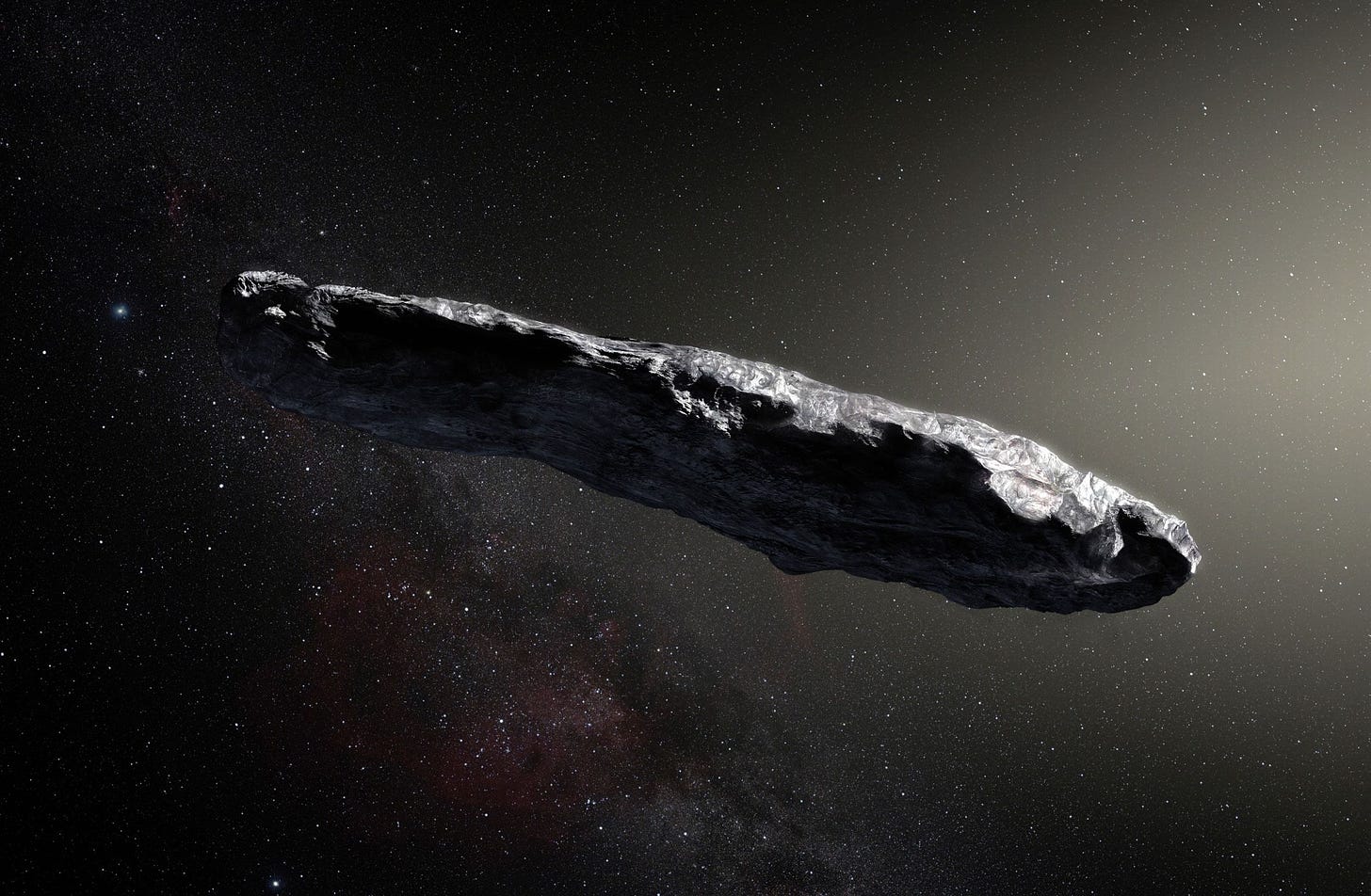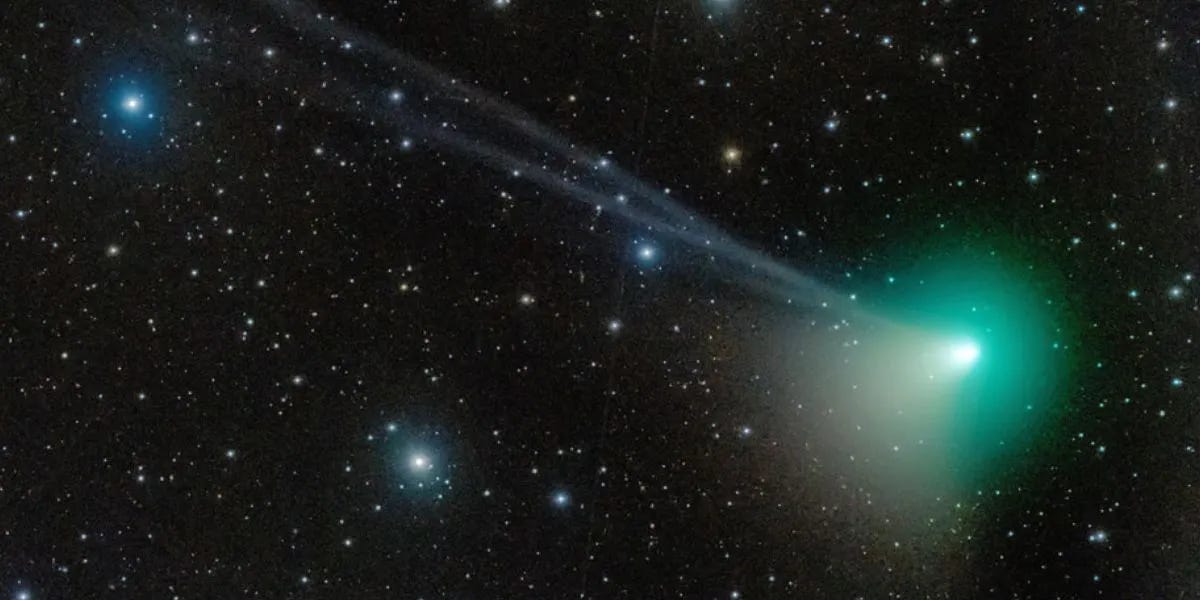On October 19, 2017, Robert Weryk discovered an object using the Haleakalā Observatory in Hawaii, that earned the name ‘Oumuamua (or, 1I/2017 U1, among scientists). Not long after the discovery, Avi Loeb, from Harvard University’s Galileo Project, created headlines by stating, “Most likely it is of natural origin, but because it is so peculiar, we would like to check if it has any sign of artificial origin, such as radio emissions.”
The apparently curious shape of the object, along with Loeb’s provocative statements then and thereafter, led to widespread speculation that aliens—or at least an alien-made object—had passed by Earth. Adding fuel to that fire, Loeb published a scientific paper wherein he offered a very carefully considered natural explanation for certain of the odder features of ‘Oumuamua, but then shifted into some conjecture about the “artificial origin[s]” of the object. He wrote, “one possibility is that ‘Oumuamua is a lightsail, floating in interstellar space as debris from advanced technological equipment.”
In support of this claim, he stated further “The lightsail technology might be abundantly used for transportation of cargo between planets.” Later he made an even more audacious claim saying, “a more exotic scenario is that ‘Oumuamua may be a fully operational probe sent intentionally to Earth vicinity by an alien civilization.”
Despite Loeb’s fanciful speculations, and while such sci-fi-styled fantasizing can be lots of fun to consider, the most reasonable conclusion based on the available evidence on ‘Oumuamua is that it is an interesting, but almost certainly natural, phenomenon. Sadly, scientists discovered ‘Oumuamua very late, so the object came and went out of observational range quite quickly. Still, they have been able to learn quite a bit about it.
Source: M. Kornmesser/European Southern Observatory / NASA
The Intrigue about ‘Oumuamua
Shape and Rotation
Among the many things weird about ‘Oumuamua is its shape. Unlike most space objects, ‘Oumuamua might be as much as 10 times longer than it is wide. The word “might” applies here because no one managed to capture a photo of it. Scientists base their estimations on its shape and size on the object’s brightness and the oscillation of the object’s reflectivity over an 8-hour cycle.
As the object’s observed brightness level changed over set periods of times, scientists could determine its shape and size by comparing these observations to models developed from observations of other bodies and mathematically predicted behavior based on the effects of gravity. The process is obviously a bit complex, but you can explore it in detail here.
One group of scientists noted that “the shape and rotation state do not particularly imply any specific analog in our solar system.” In other words, we haven’t seen a comet or asteroid in our solar system with a similar shape or moving in the same manner. To explain this, these scientists suggested that the object’s makeup was similar to what we understand to be the composition of comets, but its external surface and overall shape was different as a result of millions of years spent careening through the cold dark of interstellar space. This is admitted speculation because ‘Oumuamua is probably the first confirmed body we have witnessed that originated from outside the solar system.
Regarding its rotation, ‘Oumuamua’s reflective cycle indicates that the object is in “an excited rotational state undergoing non-principal axis rotation, or tumbling.” Based on an assessment of the average random motions of nearby stars, ‘Oumuamua’s movement suggests it is unlikely that it originated as an outgrowth from any of them. If true, this means it has come from somewhere much farther away. The unusual nature of its rotation might be less notable if it were not for another peculiar aspect of its movement.
Acceleration
Measurements from the first observations in mid-October 2017 through the last observations obtained by the Hubble Space Telescope on January 2, 2018, caused scientists some pause. ‘Oumuamua accelerated at a rate inconsistent with the forces of gravity as it propelled around the sun.
While most celestial bodies, such as asteroids, move based upon the orbital gravity acting upon them, comets’ trajectories can be altered by outgassing. ‘Oumuamua lacked the typical visual indicators of a comet—it had no tail or “coma.” As they come near stars and subsequently heat up, they form a sort of mini atmosphere around their nucleus—the coma. This gives the comet its “head,” while the stream of released gases extending behind the comet’s path, often driven by solar winds and other forces, form its tail. So if ‘Oumuamua didn’t have these features, what caused it to accelerate?
A typical comet - Source: NASA - Jose Francisco Hernández
Moving more like a comet than an asteroid, but without the telltale signs of outgassing, scientists were forced to analyze the object’s non-gravitational acceleration more closely. Notably, ‘Oumuamua is substantially smaller than typical comets.
Jennifer Berner, of the University of California at Berkeley, stated that ‘Oumuamua’s small size means it would require only a ‘tiny push’ from outgassing hydrogen, which would be very difficult to see compared to larger comets. As no outgassing was detected—again, probably because of the object’s tiny size—scientists have had to speculate on whether outgassing happened and what material was expelled.
Darryl Seligman (Yale), along with his advisor Greg Laughlin (also Yale), and Konstantin Batygin (Caltech) calculated that the sun could have vaporized ice collected on the outside of ‘Oumuamua over its long voyage in interstellar space. The resultant thrust from this vaporization would explain the acceleration and rotation, and fit with the projected size of the object. Roman Rafikov, of the University of Cambridge, believes this form of acceleration would have resulted in a more significant change in the object’s spin, but there simply wasn’t enough data to adequately measure it.
Another explanation, put forward by Avi Loeb, is that solar radiation pressure could have caused the acceleration. Loeb notes, however, that for this pressure to be effective enough, ‘Oumuamua’s mass-to-ratio must be very small, which is also uncertain.
Daryl Seligman later noted that Jennifer Berner’s theory on the source of the acceleration is “exactly what should happen to interstellar comets” and decided to collaborate with her on a paper about it. Published in September of 2022, the paper was well-received. Karen Meech of the Institute for Astronomy at the University of Hawaii called it an “interesting, creative idea,” but noted that ‘Oumuamua could have had a normal (meaning like other comets) outgassing event that simply wasn’t detected. After all, she said that ‘Oumuamua was small and dark compared to usual comets.
Whoever is correct, it is worth pointing out that the acceleration at issue comprises a very tiny—if statistically noteworthy—rate above that of the usual gravitationally-induced amount. Also of note, scientists have since discovered six other comets without a visible coma that they call “dark comets.” These so-called dark comets exhibit the same acceleration deviations as ‘Oumuamua’s, suggesting the phenomenon is actually quite common.
Origin
Another thing that has puzzled scientists about ‘Oumuamua is its origin. Because of its extraordinary speed upon arrival, and some of its other features noted above, scientists believe it must have come from outside the solar system. Its path indicates that it came from the general direction of the constellation Lyra. As NASA scientists explained, its path pointed specifically in the direction of the star Vega in the Lyra constellation, but even assuming ‘Oumuamua traveled at its highest measured speed, it would have taken 300,000 years to arrive in the solar system from the area near Vega.
The problem is that Vega was not there 300,000 years ago. Thus pinpointing ‘Oumuamua’s exact location of origin remains elusive. One paper examined the possibility of the object emanating from the Oort Cloud of the α Centauri system, but concluded that “'Oumuamua does not appear to be comoving with any of these nearest systems.” Another paper posited that 'Oumuamua could have been part of a larger body ripped into elongated fragments from a close encounter to a star. This process, said one of the authors, could cause “each planetary system [to] eject in total about 100 trillion objects like 'Oumuamua,” on average. Still, that brought them no closer to identifying an originating system.
In an effort toward identifying the place of its creation, a group of scientists has formed something called Project Lyra. In light of the discovery of a second interstellar object, named Borisov, these scientists are analyzing the feasibility of sending a mission to conduct a “fly-by” of ‘Oumuamua to attempt to learn more about it. (Borisov is moving much faster, thus the focus on ‘Oumuamua.) To reach ‘Oumuamua, a spacecraft would have to “chase” it as it is currently enroute to leaving the solar system. See here for their detailed proposal related to this project.
Could ‘Oumuamua be Alien Technology?
As far as I can find, Avi Loeb is the only credible scientist who has suggested that ‘Oumuamua could be alien technology. In 2021, he wrote, “the possibility of an artificial origin for ‘Oumuamua must be considered.” He noted that, among other things:
[Based on some of its features] it was unlikely to originate from a nearby star system. And distant stars are moving much faster relative to this local frame because of the Galactic rotation velocity profile. If ‘Oumuamua is artificial, then its initial conditions might have been tailored, for example to hide the identity of its host star system.
David Axe of the Daily Beast characterized Loeb’s statement as a public profession of “what others may only have been thinking.”
Perhaps.
Loeb has repeatedly said that there could be natural origins for the object, but some of the data, and its limitations, makes it hard to confirm. On this, I think all scientists would agree. As such, he also advocates for maintaining the possibility of there being a more “artificial” explanation. On this, I agree. The idea that some technologically capable civilization somewhere out in interstellar space created and sent ‘Oumuamua is far more plausible than the idea that grainy images of “tic tacs” zipping around the middle atmosphere here on Earth show alien ships. And unlike the many people heralding themselves as experts on what those grainy images show, Loeb is an actual expert in astrophysics. He proves it time and again in his analyses about the potential for alien origins of this object.
On the flip side of this argument, however, is that the burden of proof rests solely with those inclined to proffer the possibility that ‘Oumuamua comes from some other civilization. As the saying goes, ‘extraordinary assertions require extraordinary proof.’ To date, concrete evidence backing the alien tech argument remains scant, and what little there is is entirely speculative.
What is fascinating is that scientists are nonetheless testing some of Loeb’s ideas, which is precisely what the scientific community should do in the face of extraordinary circumstances. As an example, one team has published a paper casting serious doubt on one of Loeb’s hypotheses, that ‘Oumuamua might be a lightsail-powered craft. They concluded:
After applying these analyses in the context of the first discovered ISO ‘Oumuamua, we find its observed properties to be incompatible with those expected from the light-sail hypothesis.
Loeb’s argument—and Zhou et. al.’s counterarguments—are based on our current understanding of one method of propulsion, but as David Specht of the University of Manchester says, “The chances of alien civilizations possessing much more advanced technology than us is quite likely, in my opinion.”
Matthew Knight, of the University of Maryland, generally discounts the probability of the involvement of any alien technology, stating “The alien spacecraft hypothesis is a fun idea, but our analysis suggests there is a whole host of natural phenomena that could explain it.” The ‘Oumuamua ISSI Team that Knight leads, is an international group of scientists whose primary job has been to study ‘Oumuamua. It published a detailed paper on the various data that indicates much higher odds of it having a natural origin over it being alien tech.
Whatever the truth is, it may take quite some time to discover it. In the meantime, the scientific exchanges over the issue, including many carefully crafted and executed studies, reflects the exact approach we should follow to any perplexing problem. It is too bad we seem to lack the same vigor for more earthly problems.
Note: The name ‘Oumuamua is a Hawaiian word meaning “scout” or “messenger.” The character [‘] at the beginning of the word is an (‘okina), representing a glottal stop. See here for more.
* * *
For a fascinating and carefully considered discussion on why there is a greater challenge to scientifically studying localized UAP incidents than there is in studying possible artificial origins of phenomena like ‘Oumuamua, see the video below. UAPs (also known as Unidentified Anomalous Phenomena) are the newly minted term for what were once called UFOs. If you are interested in exploring the scientific process generally, I highly recommend you subscribe to Professor David Kipping’s channel, Cool Worlds Lab, or visit the Cool Worlds Lab website.
* * *
I am a Certified Forensic Computer Examiner, Certified Crime Analyst, Certified Fraud Examiner, and Certified Financial Crimes Investigator with a Juris Doctor and a master’s degree in history. I spent 10 years working in the New York State Division of Criminal Justice as Senior Analyst and Investigator.
Visit the new Evidence Files Facebook page; Like, Follow or Share! Or visit the Evidence Files Medium page for more on law, politics, and history. To support my work, consider Buying Me A Coffee.
For an article that makes a careful examination of another extraordinary view, click below. And thanks for reading!






